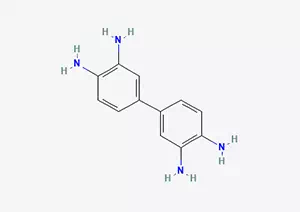All Categories



3,3-diaminobenzidine CAS 91-95-2, 3,3-diaminobenzidine, CAS 91-95-2
In the vast world of chemistry, 3,3 '-diaminobenzidine (DAB) plays an extremely important role. As a precursor of polybenzimidazole, it has unique chemical significance and wide application value.
CAS : 91-95-2
Formula : C12H14N4
Mol. wt. : 214.27
EINECS : 202-110-6
Chemical Name | 3,3′-Diaminobenzidine |
Other Name | DAB; 3,3′-Diaminobenzidine IN STOCK; 3,3′-Diaminobenzidine Factory; 3,3′-Diaminobenzidine COA TDS MSDS |
CAS | 91-95-2 |
EINECS | 202-110-6 |
Type | Organic raw materials |
Molecular Formula | C12H14N4 |
Molecular Weight | 214.27 |

Melting point | 175-177 °C(lit.) |
Boiling point | 344.41°C (rough estimate) |
density | 1.1726 (rough estimate) |
refractive index | 1.5000 (estimate) |
Fp | 12 °C |
storage temp. | room temp |
solubility | 0.55g/l |
pka | 4.39±0.10(Predicted) |
form | tablet |
color | Crystals from MeOH |
PH | 7 (1g/l, H2O, 20℃) |
Water Solubility | 0.55 g/L (20 ºC) |
Sensitive | Light Sensitive |
In the vast world of chemistry, 3,3 '-diaminobenzidine (DAB) plays an extremely important role. As a precursor of polybenzimidazole, it has unique chemical significance and wide application value.
DAB plays an indispensable role in the field of immunohistochemical staining of nucleic acids and proteins. In complex biological sample analysis, it acts like a precise "detective", capable of specifically binding to target nucleic acids or proteins, and clearly showing the location and distribution of target substances through color reactions, providing reliable basis for researchers to deeply study the physiological and pathological states of cells. Meanwhile, it also demonstrates outstanding ability in detecting fingerprints in the blood. When confronted with blood fingerprint evidence in complex environments such as crime scenes, DAB can undergo a sophisticated chemical reaction with hydrogen peroxide in the presence of hemoglobin, being oxidized into a dark brown product, thus making the originally hard-to-detect fingerprints clearly visible and providing strong support for criminal investigation work.
Visually, 3,3 '-diaminobenzidine presents a grayish-white crystalline powder form. Its chemical structure is quite distinctive, composed of two benzene rings bridged by nitrogen atoms. This unique structure endows it with distinctive stability and reactivity. In various chemical reaction environments, it can not only maintain a certain stability but also react with related substances under specific conditions, demonstrating the unique charm of its chemical properties.
However, in terms of safety, we must remain highly vigilant about 3,3 '-diaminobenzidine. It is clearly classified as a toxic substance, and its toxicity level is determined to be toxic. This means that during the process of transportation and use, any negligence may cause serious damage to human health and the environment. Therefore, whether in the research operations in the laboratory or in the application links of industrial production, a series of rigorous safety operation procedures must be strictly followed. From wearing appropriate protective equipment to ensuring good ventilation in the operating environment, every detail is related to the life safety of personnel and the ecological balance of the surrounding environment.
With the increasing emphasis on sustainable development and environmental protection worldwide, the development of green and environmentally friendly materials has become an important direction and inevitable trend for the development of the chemical industry. Under such a broad background, 3,3 '-diaminobenzidine, as an important raw material for high-temperature resistant materials, improving its green and environmental protection performance will undoubtedly become the focus of future research work. To achieve this goal, researchers are actively exploring various effective approaches. For instance, by improving the production process, adopting more environmentally friendly and efficient synthesis methods and reaction conditions, energy consumption and waste emissions during the production process can be reduced; At the same time, strengthen the monitoring and management of each link in the production process to ensure that every step meets the standards and requirements of green environmental protection, thereby achieving the green production and application of 3,3 '-diaminobenzidine and contributing to the sustainable development of the chemical industry.
Furthermore, with the continuous advancement of science and technology and the continuous emergence of new fields, the application fields of 3,3 '-diaminobenzidine are showing a trend of continuous expansion. In the field of new energy, it can be used to prepare high-performance battery materials due to its excellent chemical properties. These battery materials feature higher energy density, longer service life and better safety performance, and are expected to provide new solutions to global energy problems. In the field of electronic information, the unique electrical properties of 3,3 '-diaminobenzidine are like a mysterious treasure, providing brand-new ideas and directions for the development of new electronic devices. It may be applied to manufacture more efficient and sensitive key components such as electronic sensors and memories, promoting the rapid development of the electronic information industry. It can be foreseen that in the future development of science and technology, 3,3 '-diaminobenzidine will continue to play an important role and bring more possibilities to the progress and development of human society.

In today's fields of chemistry and materials science, 3,3 '-diaminobenzidine (DAB) plays an extremely important role, especially demonstrating unique value in the preparation of high-strength materials such as nucleic acid staining and high-temperature resistant polymers such as bulletproof vests.
In the preparation of high-strength materials related to nucleic acid staining, 3,3 '-diaminobenzidine, with its unique chemical properties and structural characteristics, can participate in complex chemical reaction processes, endowing the materials with high-strength characteristics. This ensures that the materials can still maintain structural integrity and stability under various complex environments, such as high load and high pressure conditions. So as to meet the high requirements for material strength in work such as nucleic acid staining. In the preparation of high-temperature resistant polymers such as bulletproof vests, it is an indispensable key component. When exposed to high-temperature environments, common materials may deform, melt or even decompose. However, high-temperature resistant polymers prepared with the participation of 3,3 '-diaminobenzidine can withstand extremely high temperatures, maintain their original properties and shapes, provide reliable protection for the wearer, and effectively resist high temperatures and possible accompanying impacts and other dangers.
The application scope of 3,3 '-diaminobenzidine is extremely wide, almost penetrating into every research field. In terms of the current actual situation, it is mainly widely used as a monomer in the preparation of high-temperature resistant resins and fiber materials. During the synthesis process of these materials, the molecular structure of 3,3 '-diaminobenzidine can undergo specific chemical reactions with other substances, constructing a high-molecular chain structure with high-temperature resistance. This enables the final formed resin and fiber materials to have excellent high-temperature resistance and be able to work stably for a long time in high-temperature environments. For example, it has important applications in the manufacturing of protective equipment in some high-temperature industrial environments and other aspects.
However, although 3,3 '-diaminobenzidine is widely used in fields such as material preparation, its application in the field of analysis is not common. At present, its main application in the field of analysis is concentrated on the determination of selenium content by spectrophotometry. During the specific analysis process, 3,3 '-diaminobenzidine can undergo a specific chemical reaction with selenium, generating signal changes that can be detected by a spectrophotometer. Thus, by measuring these signal changes, the selenium content in the sample can be accurately determined, providing an effective means for elemental analysis in related fields.
In addition to the above applications, 3,3 '-diaminobenzidine also has a variety of important uses. It is often used as a peroxidase substrate and selenium spectrophotometric reagent, playing a significant role in biochemical analysis and other experiments. DAB also has an outstanding performance in the immunohistochemical staining of nucleic acids and proteins. As a dark brown dye, it can specifically bind to antibodies and act as an antibody-specific dye, thereby clearly identifying paired antibodies in breast tissue and providing a powerful tool for medical research and disease diagnosis. In addition, it can also be used to synthesize useful linear Schiff base coordination polymers, expanding its application scope in fields such as coordination chemistry and materials science.
It is worth mentioning that 3,3 ',4,4 '-tetraminodiphenyl (that is, 3,3' -diaminobenzidine) has unique advantages in the production of polybenzimidazole-based fibers. This kind of fiber, due to its special chemical composition and structure, possesses excellent properties of high-temperature resistance and chemical resistance. Fabrics made from these fibers have extremely high fire safety. They will not burn even in flames and will not melt like some ordinary materials when exposed to flames. They will not harden during the carbonization process and always maintain a certain degree of flexibility and structural integrity. For this reason, this type of fabric is highly suitable for the production of protective clothing, providing reliable protection for personnel engaged in high-risk operations and preventing them from being harmed when exposed to high temperatures, flames, and various chemicals. Meanwhile, they can also serve as important materials for smoke filters, effectively filtering out harmful smoke particles in the air and ensuring the safety of people's lives. In addition, due to its excellent performance, it can also be used as a substitute for asbestos, reducing the harm of asbestos while meeting the demands of related fields for high-temperature resistant and chemical-resistant materials.
In addition, DAB (3,3 '-diaminobenzidine) is widely used in many applications to visualize peroxidase activity. In the complex biochemical process of peroxidase reaction, DAB plays a crucial role. It acts as a hydrogen donor in the presence of hydrogen peroxide and participates in the reaction system. As the reaction proceeds, the oxidized DAB forms an insoluble brown end product, which has distinct color characteristics and can be observed intuitively. Therefore, it is widely used in immunohistology and Western blotting staining procedures, helping researchers accurately detect and analyze related biological samples. It provides important technical support for life science research and medical diagnosis.
* Prompt reply and 24 hours online, professional team to provide best price and high quality product.
* Sample testing support.
* Every batch of products will be tested to ensureits quality.
*The packing also can be according the customers` requirment.
*Any inquiries will be replied within 24 hours.
*we provide Commerical Invoice, Packing List, Bill of loading, COA , Health certificate and Origin certificate. If your markets have any special requirements, let us know.